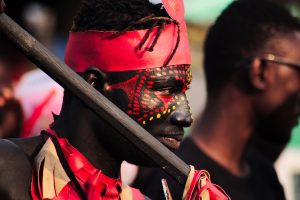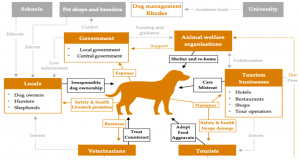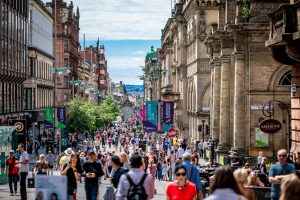Introduction
The term “Big Data” started its drastic growth “journey” in the 1990s (Diebold, 2018; Cox & Ellsworth, 1997; Mashey, 1998; Lohr, 2013), and has become especially important in the “last decade” (Akoka, Comyn-Wattiau, & Laoufi, 2017, p. 106; Baggio, 2016). In effect, big data has had a major impact on the tourism industry and throughout the whole travel system (Fuchs, Höpken, & Lexhagen, 2014; Xiang, Schwartz, Jr., & Uysal, 2015) e.g. in marketing (Ritchie & Ritchie, 2002; Lee, 2017), travel distribution (London School of Economics and Political Science, 2016), geobased travel services (Martin, Alzua, & Lamsfus, 2011; Hawelka, et al., 2014; Gong, Liu, Wu, & Liu, 2015), and customised tourism (Venturini & Ricci, 2006).
Customised tourism is a type of travel which is designed and realised to match tourists’ personal situation, preferences, “interests, and other aspects related to personal life” (Bordoni, Gisolfi, & Trezza, 2010, p. 73). It is an independent travel mode, markedly different from mass tourism. In China, customised tourism has been becoming more and more popular (Economic Information Daily, 2017). The demand from Chinese customised tourists had “a yearly growth of 400%” (China National Tourism Administration & Shenwan Hongyuan Securities, 2017, p. 17).Meanwhile, in China, big data is ‘hot’, which is underpinned by the national and strategic emphasis (Ma, Ouyang, & Yang, 2018). “A national big data strategy is being implemented in China” (Ma, Ouyang, & Yang, 2018) (Para. 4) and China is expected to become the globally largest data host by 2020 (Ma, Ouyang, & Yang, 2018).
The thesis underlying this article investigated the possibilities of big data facilitating customised tourism for Chinese tourists.
Methods
The research was based on qualitative research, whereby in-depth interviewing was taken as the leading method complemented by preliminary interviewing, participant observation and desk research.
16 semi-structured in-depth interviews were conducted (Blandford, 2013), whereby interviewees included both tourists and stakeholders from all the three trip phases: pre-trip, in-trip and post-trip (Kheiri & Nasihatkon, 2015; Yilmaz, Yilmaz, İçigen, Ekin, & Utku, 2009; Hills, 2012). Examples of stakeholders that were interviewed were Ctrip (the largest online travel agency of China)(China National Tourism Administration & Shenwan Hongyuan Securities, 2017), Unique Way (Chinese International Customised Travel Agency), TUI, Singapore Airlines, KLM Royal Dutch Airlines, the China Outbound Tourism Research Institute (COTRI), Sun Yat-Sen University of China and the Travel Channel of Sina Weibo (an influential social media channel in China with 313 million active users in 2016) (China Press, Broadcasting and TV News, 2017).
Findings
Pre-trip phase
In the pre-trip phase, the major focuses were on the themes ‘travel impulse’ and ‘travel planning and booking’.
Travel impulse. Customized tourism offers tourists a wealth of travel options and means of travelling. More options can however also make it more difficult to make choices, and lead to hesitation. Therefore, how to push tourists’ travel impulses and attract their attention is an inevitable topic. Big data has been helping “stimulate travel impulses” (Zhang, 2017; Li, 2017). Ever-increasing data volumeenhances the possibilities of bringing more specific travel information to the tourists through targeted “marketing and promotion” (Klomberg, 2017; Zhong, 2017; Werker, 2017; Joolen, 2017) which stimulates and improves the decision-making processes. One of the major sources of big data (Yaqoob, et al., 2016), social media messages, is exerting a significant influence in the pre-trip phase. Traveldata stored and disseminated through social media, such as information on novel destinations and previous tourist reviews, create trends and are driving forces for tourists. For instance, Li (2017), told the author that the travel stories presented by Sina.com, and the information shared on their social media platform, were stimulating the tourists’ travel impulses.
Travel Planning and Booking. The possibility for customised travel planning and booking are considered as the most visible part of the application of big data. Big data and related technologies have simplified and improved these processes by means of real-time direct information, previous experience data, a large number of participating stakeholders and state-of-the-art electronic commerce and internet technologies (Kramer, Modsching, & Hagen, 2007; Biesiada, 2016; Zhang, 2017; Liu, 2017). The transparency and efficiency of big data not only diversifies the options for travel planning and booking, but also makes it possible for tourists to acquire stronger voices in the market and gain more benefits (e.g. lower price and better service) because of further competition (Zhang, 2017).
In-trip phase
The benefits of big data for the in-trip phase of tourism are various. Here these are subdivided into the themes ‘On-site facilities’ and ‘Transportation facilitation’.
On-site Facilitation. A variety of big data applications can be used by tourists at their destinations. Examples are “mobile navigation” (Kramer, Modsching, & Hagen, 2007, p. 381; Zhong, 2017), accommodation, catering and attraction recommendations (Akerkar, 2012; Zhong, 2017; Li, 2017; He, 2017; Sales-Representative, 2017), language tools (Zhong, 2017; Li, 2017) and tools to interact and communicate with other tourists (Gretzel, 2011; Li, 2017) etc. Big data generates the possibilities to optimise the in-trip experience and to reduce the burdens of practical issues.
Transportation Facilitation. Transportation between origin and destination and between destinations can be improved through big data. For example, KLM has conducted a project, in collaboration with the airports and tourism boards in Brazil, using big data analysis to predict trends in tourism and optimise the flight schedule between the Netherlands and Fortaleza (Joolen, 2017). For customised tourism, transportation data and facilitation are extremely important because there is more freedom to choose transportation, but the tourists also face more uncertainty. In Lisbon, as observed by the author, a large proportion of Chinese tourists used big-data-based technologies, such as a mobile search for transportation options and timetables, when moving from one destination or attraction to another.
Post-trip phase
The main findings with respect to big data in the post-trip phase are related to feedback and sharing. The desire to express themselves and to share their experiences is part of the nature of Chinese tourists (Guo, 2017). After finishing a trip and arriving back home, Chinese tourists like to give their feedback on various services and share their experiences and feelings by means of writing travel articles or posting via social media (Zhang, 2017; Li, 2017). The feedback and sharing content become part of big data and can exert influence on future travel decisions by the same and other tourists.
Travel impulse. Customized tourism offers tourists a wealth of travel options and means of travelling. More options can however also make it more difficult to make choices, and lead to hesitation. Therefore, how to push tourists’ travel impulses and attract their attention is an inevitable topic. Big data has been helping “stimulate travel impulses” (Zhang, 2017; Li, 2017). Ever-increasing data volumeenhances the possibilities of bringing more specific travel information to the tourists through targeted “marketing and promotion” (Klomberg, 2017; Zhong, 2017; Werker, 2017; Joolen, 2017) which stimulates and improves the decision-making processes. One of the major sources of big data (Yaqoob, et al., 2016), social media messages, is exerting a significant influence in the pre-trip phase. Traveldata stored and disseminated through social media, such as information on novel destinations and previous tourist reviews, create trends and are driving forces for tourists. For instance, Li (2017), told the author that the travel stories presented by Sina.com, and the information shared on their social media platform, were stimulating the tourists’ travel impulses.
Travel Planning and Booking. The possibility for customised travel planning and booking are considered as the most visible part of the application of big data. Big data and related technologies have simplified and improved these processes by means of real-time direct information, previous experience data, a large number of participating stakeholders and state-of-the-art electronic commerce and internet technologies (Kramer, Modsching, & Hagen, 2007; Biesiada, 2016; Zhang, 2017; Liu, 2017). The transparency and efficiency of big data not only diversifies the options for travel planning and booking, but also makes it possible for tourists to acquire stronger voices in the market and gain more benefits (e.g. lower price and better service) because of further competition (Zhang, 2017).
Conclusions
Big data has significant capacity and potential to improve customised travel experiences throughout the whole travel process. The vast amount of data, the development of data analysis technologies and tools, the diverse sources of data, the data-driven nature of customised tourism, and the positive perspectives of tourists and stakeholders in this industry underpin the broad possibilities. Big data makes it possible to stimulate Chinese tourists’ customised travel impulse by means of tailored promotion and up-to-date destination information. In the pre-trip phase, data transparency and efficiency as well as electronic commerce technologies contribute to the possibilities and convenience of travel planning and booking. During the stay at the destinations, tourists can benefit from on-siteservices such as navigation, hotel, catering and attraction selection and efficient transportation arrangement. After leaving the destinations, Chinese tourists’ passion for offering feedback and sharing travel experiences contributes to the generation of big data, and benefits future and other tourists’ trips.





